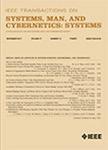版权所有:内蒙古大学图书馆 技术提供:维普资讯• 智图
内蒙古自治区呼和浩特市赛罕区大学西街235号 邮编: 010021

作者机构:College of Electrical Engineering and Automation Shandong University of Science and Technology Qingdao China Department of Mechanical Engineering University of Victoria Victoria BC Canada School of Computing Engineering and Mathematics Western Sydney University Sydney NSW Australia
出 版 物:《IEEE Transactions on Systems, Man, and Cybernetics: Systems》
年 卷 期:2018年第48卷第12期
页 面:2035-2046页
基 金:National Natural Science Foundation of China Australian Research Council Natural Science Foundation of Shandong Province Natural Science Foundation of Fujian Province China Postdoctoral Science Foundation Special Foundation for Post-Doctoral Science Foundation of Shandong Province Applied Research Project for Post-Doctoral Researchers of Qingdao Taishan Scholar Project of Shandong Province
主 题:Hidden Markov models Markov processes Communication channels Additive noise Pollution measurement Noise measurement Symmetric matrices
摘 要:In this paper, the filtering problem is investigated for a class of discrete-time Markov jump linear parameter varying systems with packet dropouts and channel noises in the network surroundings. The partial accessibility of system modes with respect to the designed filter is described by a hidden Markov model (HMM). A typical behavior characterization mechanism is proposed in the communication channel including data losses and additive noises, which occurs in a probabilistic way based on two mutually independent Bernoulli sequences. With the aid of a class of Lyapunov function subject to parameter-dependent and mode-dependent constraints, sufficient conditions ensuring the existence of HMM-based filters are obtained such that the filtering error system is stochastically stable with a guaranteed H ∞ error performance. The influence of monotonicity on the performance index is explored while changing the degree of both additive noise and mode inaccessibility. The effectiveness and applicability of the obtained results are finally verified by two numerical examples.